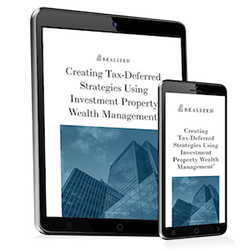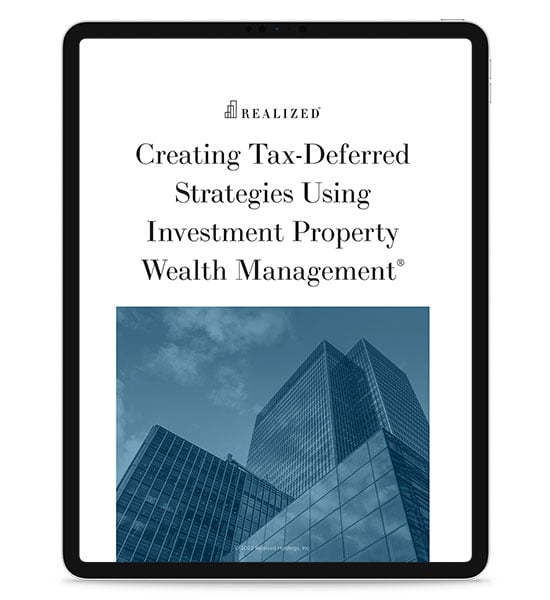
When properly structured, real estate can be an extremely tax efficient investment. Benefits are produced by the following three components:
- Depreciation
- Interest Deduction
- 1031 Exchange
Depreciation
Depreciation, in our context, is a method of reallocating the cost of a tangible asset, such as real estate, over its “useful life”. Because assets wear down over time, the IRS allows for deductions from taxable income to account for this loss of utility. Note, that depreciation allowance does not represent actual out-of-pocket expenses incurred by an investor. It is simply a deduction allowance against ordinary income. Current IRS guidelines generally allow residential real estate to be depreciated over 27.5 years and over 39 years for commercial property. Note that only the “improvements” of real estate are depreciable – no depreciation allowance is provided for the land component of an investment.
For example, assuming a commercial property is purchased for $600,000 and $100,000 is attributable to the value of the underlying land, which is not depreciable. Their depreciation deduction is:
| Purchase Price | $600,000 |
| LESS: Land Value (non-depreciable) | -$100,000 |
| EQUALS: Depeciable Basis | $500,000 |
| DIVIDED BY: Useful Life (years) | 39 |
| EQUALS: Annual Depreciation Deduction | $12,821 |
Interest Deduction
The IRS allows investors to deduct the interest portion of loan payments for investment properties from taxable income. Note that the portion of payment attributable to principal reduction is not deductible, but does benefit the investor through equity build-up.
Assuming our example property generates $48,000 per year in net operating incomes, and a loan amount of $400,000 with payments based on a 5.0% interest rate and 30-year amortization schedule, debt payments would look like:
| NOI | $48,000 |
| Debt Payment - Interest | ($19,866) |
| Debt Payment - Principal | ($5,901) |
| Cash Flow | $22,233 |
Cash Flow Benefits
To illustrate the benefits of these deductions, continuing with our example and assuming a 39.6% marginal income tax rate, the investor’s pre-tax and after-tax cash flow may look like this:
|
|
Without Deductions | With Deductions |
| Property Net Operating Income* | $48,000 | $48,000 |
| Interest Deduction | $0 | ($19,866) |
| Depreciation Deduction | $0 | ($12,821) |
| Taxable Income | $48,000 | $15,314 |
| Marginal Tax Rate | 39.6% | 39.6% |
| Tax Due | $19,008 | $6,064 |
| Pre-Tax Cash Flow | $22,233 | $22,233 |
| LESS: Tax Due | $19,008 | $6,064 |
| EQUALS: After-Tax Cash Flow | $3,225 | $16,168 |
| After-Tax Return on Equity | 1.6% | 8.1% |
| Effective Tax Rate | 39.6% | 12.6% |
In this example, by utilizing the income tax deductions, the investor ends up with five times the amount of after-tax cash flow!
1031 Exchange
Upon the sale of their investment property, investors may face a variety of taxes including Federal Capital Gains Tax, State Capital Gains Taxes, Affordable Care Act Surtax, and Depreciation Recapture Taxes. Combined, an investor could be subject to a tax rate in excess of 40% on their profit!
Continuing with our example, assuming the investor sells the property after five years for $660,000, their Realized Gain may be:
| Basis | $600,000 |
| LESS: Depreciation Taken | $64,103 |
| EQUALS: Adjusted Basis | $535,897 |
| Sale Price | $660,000 |
| LESS: Adjusted Basis | $535,897 |
| EQUALS: Realized Gain | $124,103 |
Assuming the investor is in the highest tax bracket, their potential tax liability may look like this:
| Potential Tax Liability | Tax Rate | Amount | |
| Federal Capital Gains Tax 1 | 20.00% | $12,000 | |
| State Capital Gains Tax (CA) 2 | 12.30% | $15,265 | |
| Depreciation Recapture 3 | 25.00% | $16,026 | |
| Affordable Care Act Surtax 4 | 3.80% | $4,716 | |
| TAXES DUE (Effective Tax Rate) 5 | 38.7% | $48,006 |
- Federal Capital Gains equals Realized Gain less depreciation taken multiplied by the applicable rate.
- Based on Realized Gain. Rate varies by state. Example assumes California.
- Based on sum of depreciation claimed during ownership of the investment, which is $64,103 in this example.
- Based on Realized Gain.
- Effective tax rate depicted as percentage of Realized Gain.
Fortunately, Section 1031 of the IRS Code (“1031”, or “like-kind” exchange) allows investors to dispose of an investment property while deferring taxes, provided they re-invest their proceeds into a “like-kind” investment. In our example, the investor would have an additional $48,006 to reinvest compared to paying taxes at the time of sale!
Investors who continually perform 1031-exchanges generate ever increasing cash flow and net worth, compared to real estate investors who choose to pay taxes each time they sell a property. This has a compounding effect as investors repeatedly “trade-up” into larger investments. There is no limit on the number of exchanges, and with proper estate planning, investments can ultimately transfer to an investor’s heirs upon death. The tax deferrals essentially “die” alongside the investor, as the heirs receive a step-up in basis and avoid paying the deferred taxes.
Real estate investments may provide a variety of benefits as described above. However, like all investments, real estate does have its risks and investors investors should conduct their own analysis and due diligence prior to making investments. To view a variety of passive, institutional-grade, 1031 exchange-qualified real estate investments, visit the Realized Marketplace.



